An overview of the Lāʻie Tram Tour
One of the many activities available at the Polynesian Cultural Center is the free Lāʻie Tram Tour. This 40-minute tour takes interested guests through the BYU-Hawaiʻi campus, the tiny country town of Lāʻie, and a brief stop at the historic 1919 Lāʻie Temple of the Church of Jesus Christ of Latter-day Saints.
Hours of operation: 3:00pm – 6:40pm (last tram will get participants back in time to attend HĀ: Breath of Life)
Time to complete tour: Approximately 40 minutes
Cost: This is a free tour offered by the Lāʻie Temple Visitors Center
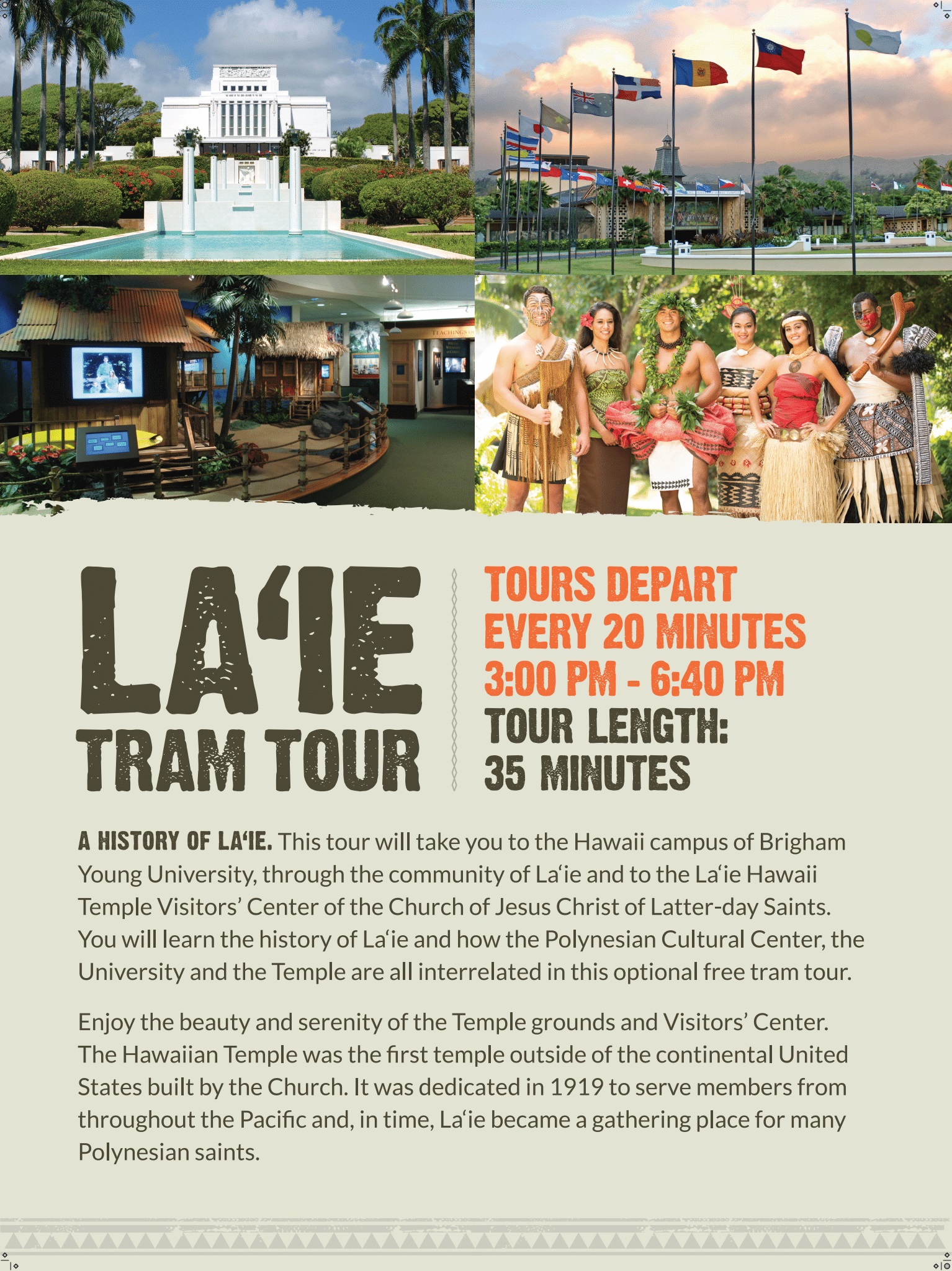
Tram Tour sign at the pick-up point for the Lāʻie Tram Tour at the Polynesian Cultural Center.
What to Expect:
The Lāʻie Tram Tour is a voluntary and free tour provided as a courtesy for those who would like to learn a little more about the history and purpose of our beautiful community of Lāʻie.
The Polynesian Cultural Center provides an in-depth experience into six Polynesian based cultures: Hawaiʻi, Aotearoa, Fiji, Samoa, Tahiti and Tonga. The activities here delve into each culture with a concentration of village life before pre-European exploration occurred.
However, the story of Lāʻie, and the Polynesian people who became members of the Church of Jesus Christ of Latter-day Saints starting in the late 1800s, is a part of Lāʻie and the Polynesian experience.
In honor of the hard work, faith and courage of Lāʻie’s early Polynesian settlers, this article explains the connection and the tour in detail.
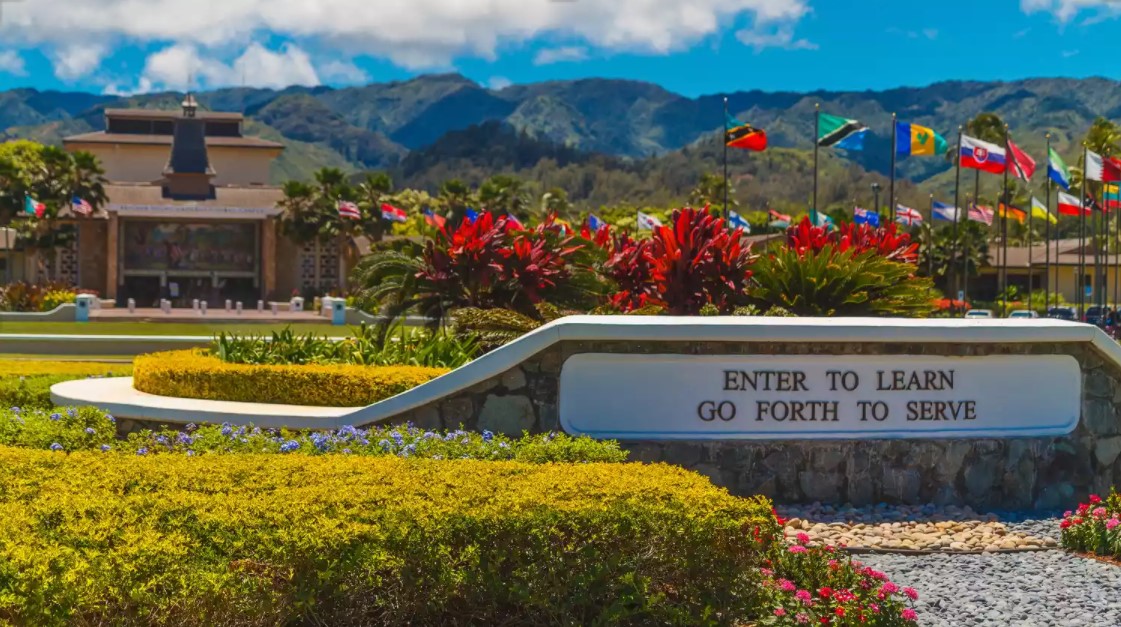
Entrance to Brigham Young University – Hawaiʻi, part of your Lāʻie Tram Tour.
Part #1: Brigham Young University – Hawaiʻi
The journey starts at the Polynesian Culture Center. Here, open air trams drive out through automated gates and onto the campus of Brigham Young University – Hawaiʻi. Your Lāʻie Tram Tour guides will explain the background of this educational marvel, dedicated to providing education and training to the many attending students from across the Pacific and beyond.
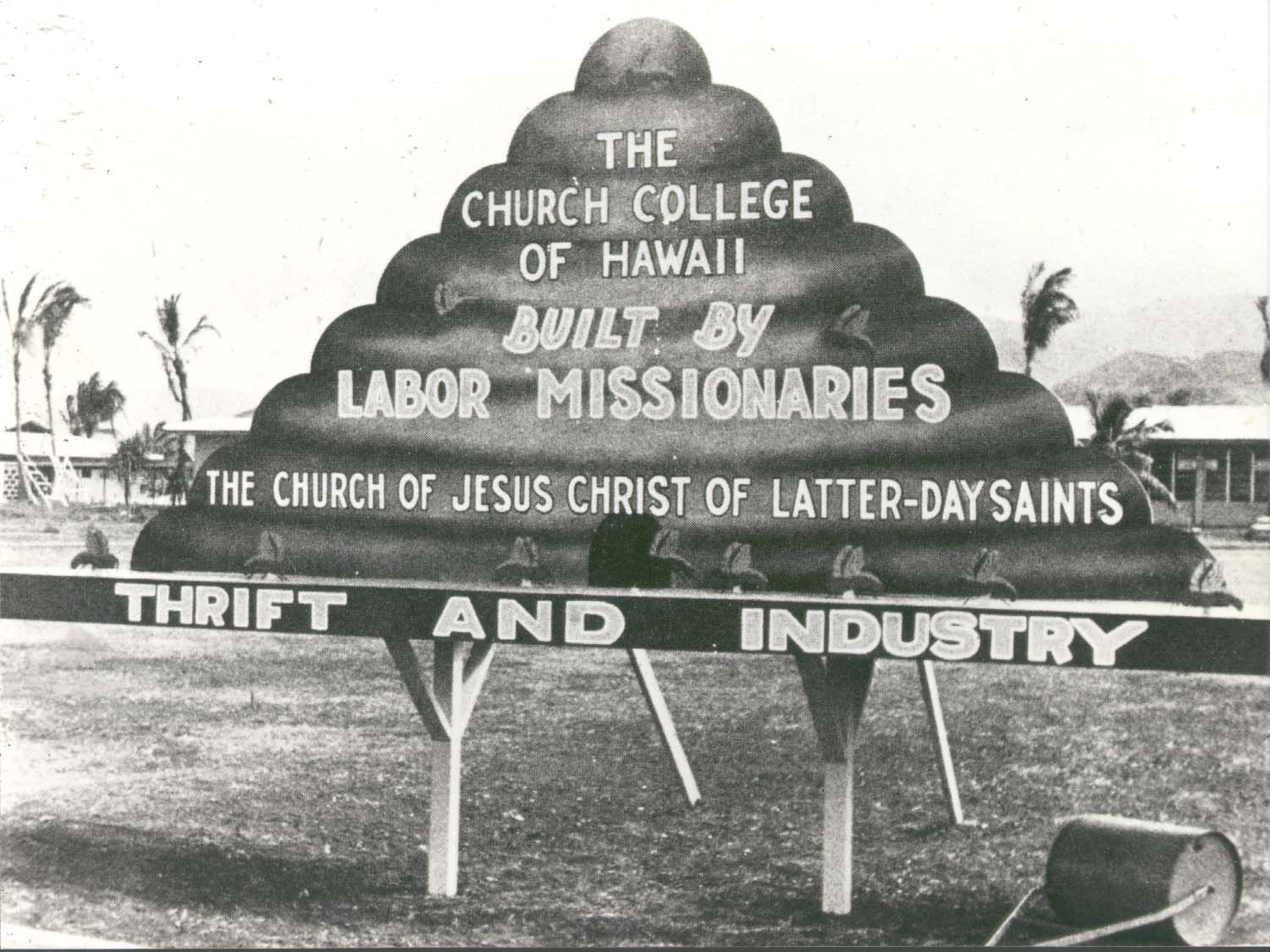
BYU-Hawaiʻi, originally named The Church College of Hawaiʻi was a built by volunteers from across the Pacific.
Digging Deeper – The history of Brigham Young University – Hawaiʻi
Providing opportunities for education and employment has always been a priority of the Church. The Polynesian Saints felt equally strongly about the need to provide opportunities for their children to obtain degrees that would help them to obtain the means to provide fully for their families. Shortly after the conclusion of World War II, the Lāʻie Saints established a goal of raising the money to establish a college here in Lāʻie.
Originally named the Church College of Hawaiʻi, the doors for higher learning opened in 1955. The enrollment for the first year was 153 students. It was built through the efforts and faith of the families of Lāʻie, who would hold weekly “Hukilaus” (a community event that consisted of gathering fish as a community and then serving them along with a buffet of local foods, along with music, and dance). At first the event focused on raising funds to rebuild a local chapel that had burnt down. When that goal was reached, their enthusiasm carried them to continue so that they could build the Church College of Hawaiʻi.
By 1959 the college had converted from a 2-year program to a full 4-year degree and in 1974 it was renamed Brigham Young University – Hawaiʻi. Currently our enrollment tops 3,000 and is steadily growing. Data shows that there are more women than men attending and that there is a healthy mix of students paying for their educations versus students who are enrolled in our iWork work study program.
Many of our students come from lands where the chance to obtain a college level degree is only a dream. Yet through the educational and training opportunities offered through BYU-H and the Polynesian Cultural Center, these youth are given the chance walk a path which allows them to become leaders, influencer, movers and shakers in their home country and to help to lift the world. Through our IWORK program, these students are provided the necessary financial assistance and important onsite training to return to their home country/region debt-free.
Some of the courses of study include Intercultural Peacekeeping, Anthropology and Cultural Sustainability, Biochemistry, Marketing, Biology, Informational Technology, Linguistics, Conservation Biology, Nutritional Science, and so much more.
We are so proud to highlight the humanitarian efforts of Brigham Young University Hawaiʻi, and to support their efforts by providing on the ground training and experience opportunities throughout our many departments. Our student workers are the backbone and the focus of all of our efforts. Sharing the beauty of Polynesia with the world is our privilege, but our true mission is our worldwide student base. It is a moving testament to the human spirit, and the desire to love and support the children of the world.

Besides the University and Temple, Lāʻie consists of one stop light, one shopping center with numerous shops and eateries, one gas station, one hotel, plus one store and restaurant over on Iosepa Street, an elementary school, a park, a cemetery and a number of residences.
Part 2: LĀʻIE
The tram travels through our little hamlet with a big history. Our little North Shore community has changed much over the years. It began as a sugar plantation, complete with an operating mill in the town of Kahuku, 3 miles to the north. Lāʻie became a place for Polynesian members to find a home where they could serve, worship, and live in peace.
As the tram takes you through some of the neighborhoods, you will see that our streets were built to encourage a tight-knit community. Many descendants of these settlers still live here, work here, and continue to strive to support one another in service and love. A large push has happened in the last few years to modernize, repair and restore the houses. Our children grow up playing in the waves, running around barefoot, eating fruit off the tree and fish from the ocean, serving their elders, and singing the songs of their ancestors.

Lāʻie in the late 1800s – early 1900s consisted of as a small village, a company store, and a sugar plantation.
Digging Deeper – the History of Lāʻie
The Lāʻie community was settled by faithful members of the Church of Jesus Christ of Latter-day Saints as a place for them to practice their faith openly and with joy.
Membership throughout the Polynesian nations grew throughout the late 1800s. But many of these members faced persecution and hardship in their native lands. They prayed for a place where they and their families could live the life they had chosen.
In January of 1865, the Church of Jesus Christ of Latter-day Saints purchased a large 6,000-acre plantation on the northeast side of Oahu. Ancient Hawaiians had established this land as a place of refuge for those seeking protection. It seemed prophetic that this tradition would be allowed to continue for the Polynesian Saints.
The gathering of Saints from across the Pacific began. But it wasn’t easy. The land was crude, almost desert like. Much work was put into raising crops, building housing, and constructing roads and shipping routes to allow access to food and supplies. Rivers were diverted, municipal water and sewer treatment systems were constructed, and places of worship were established.
It was the industrious and happy service of the Polynesian Saints, those who knew and loved their community, that helped Lāʻie to grow and prosper.

The beautiful Lāʻie Temple seen during Lāʻie Shuttle Tour
Part #3: The Lāʻie Temple of the Church of Jesus Christ of Latter-day Saints
Just a few short blocks up the hill, your tram will stop at the historic Lāʻie Temple, which has been open since 1919. It is a testimony of faith, sacrifice and hard work. You are given 20 minutes to wander along the beautiful walkways, viewing sculptures, fountains, and the magnificent flora prominent on the islands of Hawaiʻi. Or you may choose to visit our expansive Visitors Center, where you can learn more about the broad history of our community and our temples.
But we wish to be perfectly clear. This is an edifice built on faith. It is the base of Lāʻie’s history, culture, and our daily focus. The Visitor’s Center was built to help others to learn more about the building site’s purpose, or to simply enjoy. No one should feel coerced or led to anything more than a deeper understanding of the elements that make our beloved temple so dear to us. We have many tour guides who also serve as youth or senior missionaries for the Church. Their proselyting service is separate from the time they spend as guides. These volunteers are found both here on the Temple grounds and at the loading area for the tram at the Polynesian Cultural Center. Their purpose is to be available to answer questions or conduct tours. Your comfort and consideration will be paramount during your visit.
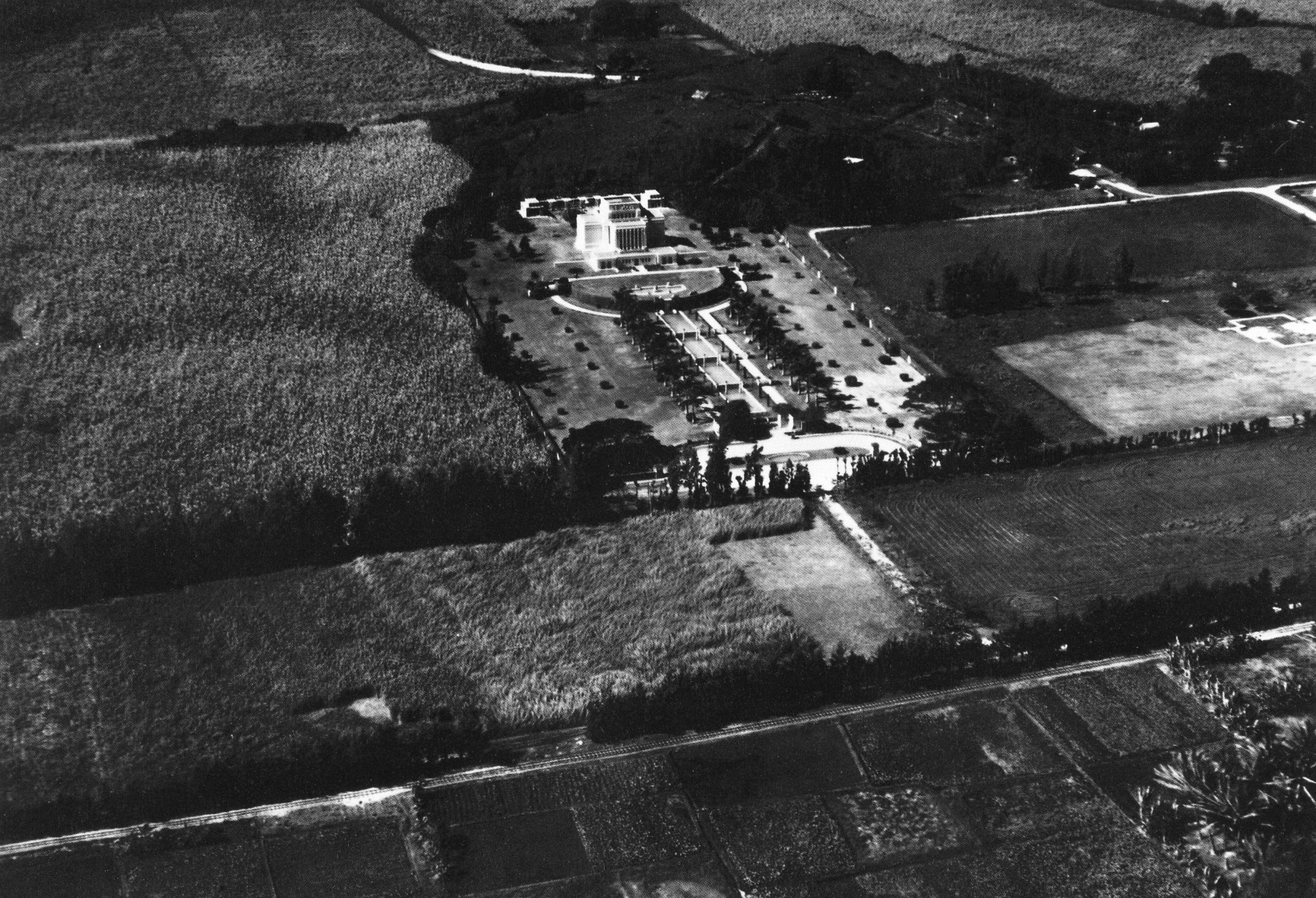
When first dedicated in 1919, the Lāʻie Temple was surrounded by sugar plants and taro fields.
Digging Deeper – The History of the Lāʻie Temple
Since it was first established in 1864, the dream of the hearts of our community members was to establish what we termed “A House of the Lord” in Lāʻie. In 1915, then Prophet and spiritual leader of the Church Joseph F. Smith. Smith himself served 4 years as a youth in Lāʻie and across Hawaiʻi, dedicated a track of land sitting on a hillside overlooking the community for the building of a Temple of God. This was to be the first temple built outside of the United States (which did not include Hawaiʻi as a state until 1959). This beautiful edifice was opened in 1919. Apart from short closures during World War II and during necessary building repairs, it has remained open from that point onward. The temple has been cherished and utilized by faithful Saints from across the Pacific and beyond.
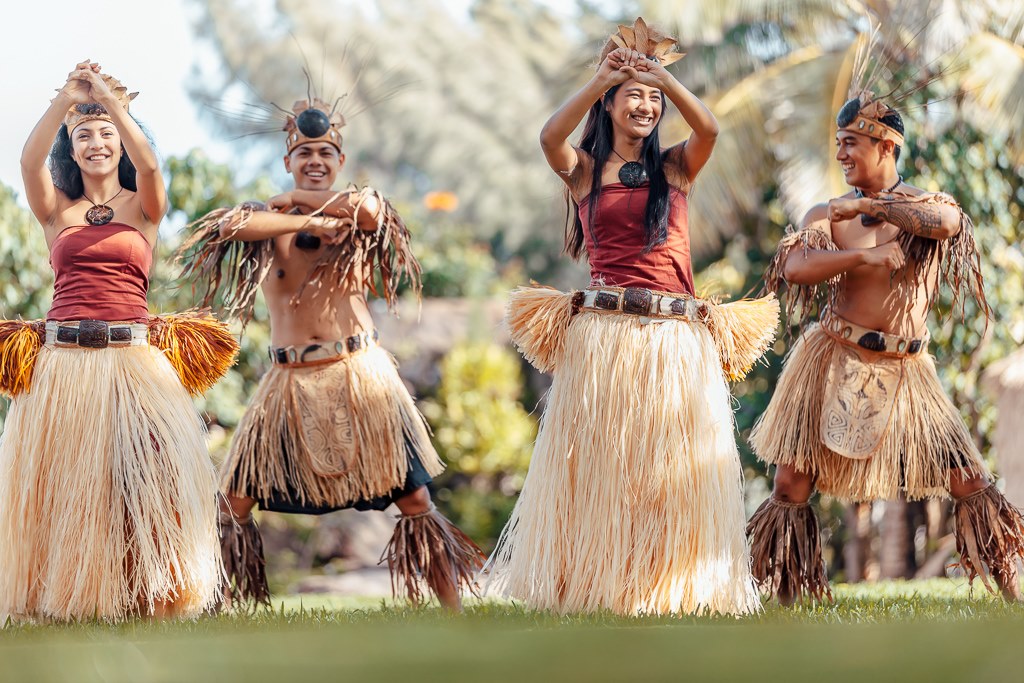
Tahitian villagers dance the ʻOri Tahiti, a fast dance with swaying hips and foot movement.
Part #4: Return to the Polynesian Cultural Center
It is then time to return to your tram to ride back to the Polynesian Cultural Center where you will continue your Polynesian experience.
We hope that you enjoy your time on the tram, or in participating in any of the many activities provided by the Center. We thank you for your visit and hope you have a wonderful experience in Hawaiʻi.
Bio of Nina S. Jones, Blogger for the Polynesian Culture Center

Nina Jones, a mainland gal from way back, is now a transplanted Islander. With her husband of 39 years, she volunteers at the Polynesian Cultural Center. Her hobbies include swimming, traveling, studying and writing about what she is learning from the various Polynesian cultures. Her blogs focus on their history, beliefs, practices and – as an added bonus – delicious food! To her, Polynesia is not just a place to visit, it is a way to live and she is very honored to be able to be a part of their amazing world.


Recent Comments